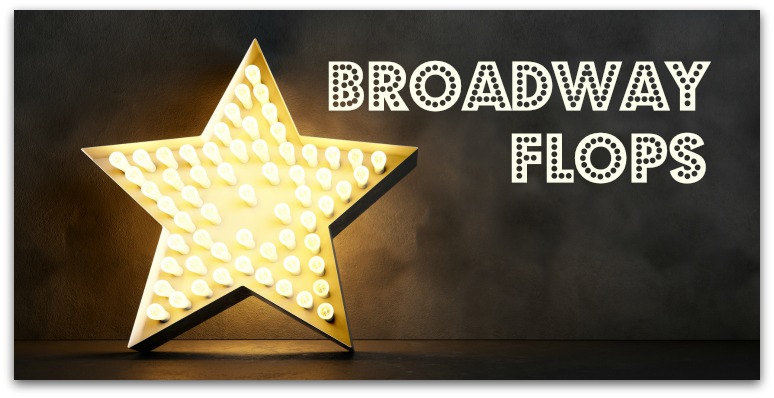If your play manages to get to Broadway, you’ve already achieved a huge accomplishment in the world of theater. But, um, then you’ve got to deliver. These folks didn’t. (This story was originally published in the 28th annual edition, Uncle John’s Factastic Bathroom Reader.)
Dude: The Highway Life (1972)
This was a much ballyhooed musical production by Gerome Ragni and Galt MacDermot, two of the creators of the 1967 hit Hair. The story revolves around Dude, a young man who battles a series of temptations from a Satan-like character named Zero. The plot was so convoluted and confusing that the actors threatened to walk out while the show was in rehearsal. Also during rehearsals, the show’s producers decided that the dude playing Dude, a 23-year-old white actor named Kevin Geer, couldn’t sing well enough to play the role. So they replaced him…with an 11-year-old African American actor (Ralph Carter, who went on to play the little brother in the 1970s sitcom Good Times). That meant all the character’s adult-centered dialogue had to be rewritten. By the time the play started previews, the production was such a shambles that both the director and choreographer quit and had to be replaced. When the show finally opened, critics hated it. So did audiences. Dude was gone after just 16 performances.
Rachael Lily Rosenbloom (And Don’t You Ever Forget It) (1973)
This play was the brainchild of 25-year-old actor, singer, and composer Paul Jabara. At the time he was known only for his performances in the musicals Hair and the London production of Jesus Christ Superstar, but he convinced music business legends Robert Stigwood (the Bee Gees’ manager) and Ahmet Ertegün (the founder of Atlantic Records) to invest $500,000 in this Broadway musical. It was a campy, over-the top disco-themed extravaganza with a story line that traces the life of Rachael Lily Rosenbloom, a Brooklyn fish market worker who becomes a famous Hollywood gossip columnist and later an Oscar-nominated actress. After just eight previews—and a string of mocking reviews, such as the one by New York Times critic Frank Rich, who called it a “musical fantasy of surpassing lavishness that made no sense, at any level, from beginning to end”—the show was closed before it even had an official opening night. Stigwood and Ertegün lost their entire $500,000 investment.
Moose Murders (1983)
This “whodunit” by playwright Arthur Bicknell was about a group of people who get stuck in the “Wild Moose Lodge” in New York’s Adirondack Mountains during a storm. Then they start getting murdered…by someone wearing a moose costume. Notable characters: a wheelchair-bound quadriplegic man entirely wrapped in gauze, and a hippie teenager named Stinky who is obsessed with trying to sleep with his mother. The only reason the play made it to Broadway was that the producers convinced longtime Hollywood star Eve Arden (Our Miss Brooks) to play the lead. But the play was so…stinky that Arden quit after the first preview. Moose Murders received some of the most scathing reviews in Broadway history. New York Post critic Clive Barnes wrote that it was “so indescribably bad that I do not intend to waste anyone’s time by describing it.” The New Yorker’s Brendan Gill said the play “would insult the intelligence of an audience consisting entirely of amoebas.” And New York Magazine said it seemed as if the play was staged by “a blind director repeatedly kicked in the groin.” Moose Murders was canceled after one performance.
Bonus fact: In 2013 Bicknell published a book entitled Moose Murdered: Or How I Learned to Stop Worrying and Love My Broadway Bomb, the behind-the-scenes story of the flopped play. And…it got great reviews.
Into the Light (1986)
This was a musical written by unknown playwright Jeff Tambornino. Plot: a nuclear physicist becomes obsessed with verifying—or debunking— the veracity of the shroud of Turin, the purported burial cloth of Jesus Christ. Alienated from his wife and his son, the physicist copes with his obsession by inventing an imaginary friend—a mime. How did Tambornino manage to get a story like that to Broadway? He got actor Dean Jones, the star of two Disney hit movies—That Darn Cat! (1965) and The Love Bug (1969)—to play the lead. (Jones had recently become a born-again Christian and liked the pro-Christianity message of the play.) The show, which was advertised as “futuristic,” featured generous use of a fog machine and lasers, as well as dancing nuns. And remember— it was a musical, so it had Jones, as the nuclear physicist, singing about molecules, quarks, antimatter, and other physics-related things. Into the Light fizzled out after six performances. The show’s producers reportedly lost around $3 million.










